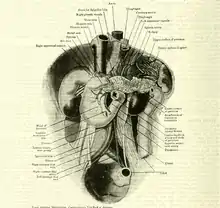674
PANCREAS
a compact gland and sometimes diffuse between the layers of the mesentery; at other times it is so surrounded by the liver as to be difficult to find.
Among the Dipnoi (mud fish), Protopterus has it embedded in the walls of the stomach and intestine.
The Amphibia have a definite compact pancreas which lies in the U-shaped loop between the stomach and duodenum, and is massed round the bile duct. In the Reptilia there are sometimes several ducts, as in the crocodile and the water tortoise (Emys), and this arrangement is also found in birds (the pigeon, for instance, has three ducts opening into the duodenum at very different levels). In mammals the gland is usually compact, though
| An image should appear at this position in the text. A high-res raw scan of the page is available. To use it as-is, as a placeholder, edit this page and replace "{{missing image}}" with "{{raw image|EB1911 - Volume 20.djvu/730}}". If it needs to be edited first (e.g. cropped or rotated), you can do so by clicking on the image and following the guidance provided. [Show image]  |
Aorta
Fossa for Spigelian lobe Right phrenic vessels
Vena cava Hepatic vein Hepatic artery
Portal vein Pylorus Bile duct * Right supra renal capsule
Œsophagus
Coronary artery Diaphragm Left supra renal capsule
Splenic artery Kidney
Upper surface of pancreas Gastric surface of spleen
Under surface of pancreas
Attachment of
transverse
mesocolon
Duodeno- jejunal flexure
Gastro-duodenal artery and neck of pancreas Superior mesenteric artery
Right common iliac vein
Right common iliac artery Left common iliac vein
Duodenum
Ureter
From Ambrose Birmingham, Cunningham's Text Book of Anatomy.
Fig. 1.—The Viscera and Vessels on the Posterior Abdominal Wall. The stomach, liver and most of the intestines have been removed. The peritoneum has been preserved on the right kidney, and the fossa for the Spigelian lobe. In taking out the liver, the vena cava was left behind. The stomach-bed is well shown. (From a body hardened by chromicacid injections.)
sometimes, as in the rabbit, it is diffuse. It usually has two ducts, as in man, though in many animals, such as the ox, sheep and goat, only one persists. When there is only one duct it may open with the common bile duct, e.g. sheep and cat, or may be very far away as in the ox and rabbit. (F. G. P.)
Diseases of the pancreas.—As the pancreas plays an important part in the physiology of digestion much attention has of late been paid to the question of its secretions. In sclerosis, atrophy, acute and chronic inflammatory changes and new growths in the pancreas an absence or lessening of its secretion may be evident. Haemorrhage into the pancreas is of some medico-legal importance as being a cause of death. The condition is rarely recognized in time for operative interference. Acute haemorrhagic pancreatitis is a combination of inflammation with haemorrhage in which the pancreas is found enlarged and infiltrated with blood. Violent pain, vomiting and collapse, are the chief features as is also the case in pancreatic abscess in which the abscess may be single or multiple. In the latter case operation has been followed by recovery. Haemorrhagic inflammation has been followed by gangrene of the pancreas, which usually terminates fatally. In two remarkable cases, however, reported by Chiari recovery followed on the discharge per rectum of the necrosed pancreas. Chronic pancreatitis is said by Mayo Robson to occur in connexion with the symptoms of catarrhal jaundice, which he suggests is due to the pressure on the common duct by the swollen pancreatic tissue. The organ is enlarged and very hard, and the symptoms are pain, dyspepsia, jaundice, loss of weight and the presence of fat in the stools. This latter sign is common to all forms of pancreatic disease. In connexion with all pancreatic diseases small yellowish patches are found in the pancreatic tissue, mesentery, omentum and abdominal fatty tissue generally, and the tissues appear to be studded with whitish areas
often not larger than a pin's head. The condition, which was